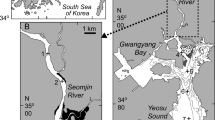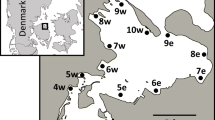Abstract
To characterize the isotopic composition of organisms at the base of the food web and the controls on their variability, the concentration and δ13C isotopic composition of dissolved inorganic carbon (DIC) and plankton δ13C, δ15N, and δ34S were measured. The measurements were made during periods of high and low river flow in Apalachicola Bay, Florida, United States, over 3 yr. DIC concentration and δ13C values were related to salinity, indicating that conservative mixing of riverine and marine waters was responsible for the overall distributions. The usefulness of DIC δ13C data for characterizing the trophic processes within the estuary was dependent upon the residence time of water within the season. Plankton δ13C values varied from −22‰ to −30‰ and were directly related to estuarine DIC δ13C, offset by a factor of roughly −20‰. This offset factor varied with salinity. Values of δ34S in estuarine plankton (station means ranged from 11.4‰ to 13.1‰) were depleted relative to marine plankton (17.7±0.4‰) possibly due to the admixture of34S-depleted sedimentary sulfide with estuarine samples. Values of δ34S in plankton were not related to δ13C values of plankton and were only weakly correlated to the salinity of the water from which the plankton were collected, indicating that marine sulfate was the primary source of planktonic sulfur. Values of δ15N in plankton varied from 5.5‰ to 10.7‰ and appeared related to dominance of the sample by phytoplankton or zooplankton. Estuarine plankton was15N enriched relative to offshore plankton and estuarine sediment.
Similar content being viewed by others
Literature Cited
Bidigare, R. R., A. Fluegge, K. H. Freeman, K. L. Hanson, J. M. Hayes, D. Hollander, J. P. Jasper, L. L. King, E. A. Laws, J. M. Milder, F. J. Millero, R. Pancost, B. N. Popp, P. A. Steinberg, andS. G. Wakeham. 1997. Consistent fractionation of13C in nature and in the laboratory: Growth-rate effects in some haptophyte algae.Global Biogeochemical Cycles 11: 279–292.
Bunn, S. E., N. R. Loneragan, andM. A. Kempster. 1995. Effects of acid washing on stable isotope ratios of C and N in penaeid shrimp and seagrass: Implications for food-web studies using multiple stable isotopes.Limnology and Oceanography 40:622–625.
Chanton, J. P., C. S. Martens, andM. B. Goldhaber. 1987. Biogeochemical cycling in an organic-rich coastal marine basin: 7. Sulfur mass balance, oxygen uptake and sulfide retention.Geochimica et Cosmochimica Acta 51:1187–1199.
Cifuentes, L. A., J. H. Sharp, andM. Fogel. 1988. Stable carbon and nitrogen isotope biogeochemistry in the Delaware estuary.Limnology and Oceanography 33:1102–1115.
Coffin, R. B., L. A. Cifuentes, andP. M. Elderidge. 1994. The use of stable carbon isotopes to study microbial processes in estuaries, p. 222–240.In K. Lajtha and R. Michener (eds.), Stable Isotopes in Ecology and Environmental Science. Blackwell Scientific Publications, London.
Coplen, T. B. 1994. Reporting of stable hydrogen, carbon, and oxygen isotopic abundances.Pure Applied Chemistry 66:273–276.
Degens, E. T., M. Behrendt, B. Fotthardt, andE. Reppmann. 1968. Metabolic fractionation of carbon isotopes in marine plankton: II. Data on samples collected off the coasts of Peru and Ecuador.Deep Sea Research 15:11–20.
Elder, J. F. and D. J. Cairns. 1982. Production and decomposition of forest litter fall on the Apalachicola River flood plain, Florida. United States Geological Survey Water-Supply Paper 2196-B. Alexandria, Virginia.
Estabrook, R. H. 1973. Phytoplankton ecology and hydrography of Apalachicola Bay. M.S. Thesis, Florida State University, Tallahassee, Florida.
Fogel, M. L. andL. A. Cifuentes. 1993. Isotopic fractionation during primary production, p. 73–98.In M. Engel and S. A. Macko (eds.), Organic Geochemistry. Plenum Press, New York.
Fogel, M. L., L. A. Cifuentes, D. J. Velinski, andJ. H. Sharp. 1992. The relationship of carbon availability in estuarine phytoplankton in isotopic composition.Marine Ecology Progress Series 82:291–300.
Freeman, K. H. andJ. M. Hayes. 1992. Fractionation of carbon isotopes by phytoplankton and estimates of ancient CO2 levels.Global Biogeochemical Cycles 6:185–198.
Fry, B. 1988. Food web structure on Georges Bank from stable C, N, and S isotopic compositions.Limnology and Ocenography 33:1182–1189.
Fry, B. andS. C. Wainright. 1991. Diatom sources of15C-rich carbon in marine food webs.Marine Ecology Progress Series 75: 149–157.
Fu, J. 1991. Atmospheric deposition of nutrients to North Florida rivers: A multivariate statistical analysis. M.S. Thesis, Florida State University, Tallahassee, Florida.
Goericke, R. andB. Fry. 1994. Variations of marine plankton δ13C with latitude, temperature and dissolved CO2 in the world’s ocean.Global Biogeochemical Cycles 8:85–90.
Goericke, R., J. P. Montoya, andB. Fry. 1994. Physiology of isotopic fractionation in algae and cyanobacteria, p. 187–221.In K. Lajtha and R. Michener (eds.), Stable Isotopes in Ecology and Environmental Science. Blackwell Scientific Publications, London.
Goering, J., B. Alexander, andN. Haubenstock. 1990. Seasonal variability of stable carbon and nitrogen isotope ratios of organisms in a N. Pacific bay.Estuarine, Coastal and Shelf Science 30:239–260.
Hinga, K. R., M. A. Arthur, M. E. Q. Pilson, andD. Whitaker. 1994. Carbon isotope fractionation by marine phytoplankton in culture: The effects of CO2 concentration, pH, temperature, and species.Global Biogeochemical Cycles 8:91–102.
Laws, E. A., B. Popp, R. Bidigare, M. Kennicutt, andS. Macko. 1995. Dependence of phytoplankton carbon isotopic composition on growth rate and CO2aq: Theoretical considerations and experimental results.Geochimica et Cosmochimica Acta 59:1131–1138.
Leboulanger, C., C. Descolas-Gros, M. R. Fontugue, I. Bentaleb, andH. Jupin. 1995. Interspecific variability and environmental influence on particulate organic carbon δ13C in cultured marine phytoplankton.Journal of Plankton Research 17:2079–2091.
Livingston, R. J. 1984. The Ecology of the Apalachicola Bay system: An estuarine profile. United States Department of the Interior, United States Fish and Wildlife Service, FWS/OBS-82/05, Washington, D.C.
Lynch-Stieglitz, J., T. F. Stocker, W. Broecker, andR. Fairbanks. 1995. The influence of air-sea exchange on the isotopic composition of oceanic carbon: Observations and modeling.Global Biogeochemical Cycles 9:653–665.
Mattraw, Jr., H. C. and J. F. Elder. 1984. Nutrient and detritus transport in the Apalachicola River, Florida. United States Geological Survey Water-Supply Paper 2196-C. Alexandria, Virginia.
Michener, R. H. andD. M. Schell. 1994. Stable isotope ratios as tracers in marine aquatic food webs, p. 138–157.In K. Lajtha and R. Michener (eds.), Stable Isotopes in Ecology and Environmental Science. Blackwell Scientific Publications, London.
Minagawa, M. andE. Wada. 1984. Stepwise enrichment of15N along food chains: Further evidence and the relation between δ15N and animal age.Geochimica et Cosmochimica Acta 48:1135–1140.
Mook, W. G., J. C. Bommerson, andW. H. Staverman. 1974. Carbon isotope fractionation between dissolved bicarbonate and gaseous carbon dioxide.Earth and Planetary Science Letters 22:169–176.
Mook, W. G. andF. C. Tan. 1991. Stable carbon isotopes in rivers and estuaries, p. 245–264.In E. T. Degens, S. Kempe, and J. E. Richey (eds.), Biogeochemistry of Major World Rivers. SCOPE Report 42. SCOPE, New York.
Peterson, B. J., R. W. Howarth, andR. H. Garritt. 1986. Sulfur and carbon isotopes as tracers of salt-marsh organic matter flow.Ecology 67:865–874.
Rau, G. H., U. Reibesell, andD. Wolf-Gladrow. 1997. CO2 aq-dependent photosynthetic13C fractionation in the ocean: A model versus measurements.Global Biogeochemical Cycles 11: 267–278.
Rau, G. H., T. Takahashi, andD. J. Des Marais. 1989. Latitudinal variations in plankton δ13C: Implications for CO2 and productivity in past oceans.Nature 341:516–518.
Smith, S. V. andJ. T. Hollibaugh. 1993. Coastal metabolism and the oceanic organic carbon balance.Reviews of Geophysics 31:75–89.
Spiker, E. 1980. The behavior of14C and13C in estuarine water: Effects of in situ CO2 production and atmospheric exchange.Radiocarbon 22:647–654.
Spiker, E. C. andL. E. Schemel. 1979. Distribution and stable isotope composition of carbon in San Francisco Bay, p. 195–212.In T. J. Conomos (ed.), San Francisco Bay, the Urbanized Estuary. American Association for the Advancement of Science. San Francisco.
Stumm, W. andJ. Morgan. 1996. Aquatic Chemistry, 3rd edition. Wiley Interscience, New York.
Sullivan, M. J. andC. A. Moncreiff. 1990. Edaphic algae are an important component of salt marsh food-webs: Evidence from multiple stable isotope analyses.Marine Ecology Progress Series 62:149–159.
Sullivan, M. J. andC. A. Moncreiff. 1993. Trophic importance of epiphytic algae in Mississippi seagrass beds. Document # MASGP 92-018. Mississippi-Alabama Sea Grant, Mississippi.
Wilbur, D. H. 1992. Associations between freshwater inflows and oyster productivity in Apalachicola Bay, Florida.Estuarine, Coastal and Shelf Science 35:179–190.
Wilbur, D. H. 1994. The influence of Apalachicola River flows on blue crab,Callinectes sapidus, in north Florida.Fishery Bulletin 92:180–188.
Yoshinari, T. andI. Koike. 1994. The use of stable isotopes for the study of gaseous nitrogen species in marine environments, p. 114–137.In K. Lajtha and R. Michener (eds.), Stable Isotopes in Ecology and Environmental Science, Blackwell Scientific Publications, London.
Sources of Unpublished Materials
Cifuentes, L. A., P. M. Eldridge, and R. B. Coffin. Unpublished Data. Department of Oceanography, Texas A&M University, College Station, Texas.
Edmiston, L. and G. Bailey. Personal Communication. Apalachicola National Estuarine Research Reserve, East Point, Florida.
Iverson, R. L., B. Mortazavi, W. Huang, and F. G. Lewis. Unpublished Data. Department of Oceanography, Florida State University, Tallahassee, Florida.
Mortazavi, B. and R. Iverson. Personal Communication. Department of Oceanography, Florida State University, Tallahassee, Florida.
Author information
Authors and Affiliations
Corresponding author
Rights and permissions
About this article
Cite this article
Chanton, J.P., Lewis, F.G. Plankton and dissolved inorganic carbon isotopic composition in a river-dominated estuary: Apalachicola Bay, Florida. Estuaries 22, 575–583 (1999). https://doi.org/10.2307/1353045
Received:
Accepted:
Issue Date:
DOI: https://doi.org/10.2307/1353045




